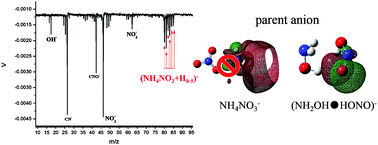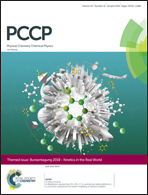Isomeric structures of isolated ammonium nitrate and its hydrogenated species identified through PES experiments and DFT calculations†
Abstract
Anion photoelectron spectroscopic (PES) experiments in conjunction with density functional theory (DFT) calculations shed light on the electronic and geometric structures of gas phase, isolated ammonium nitrate related anionic species, as well as their hydrogenated species with up to five added hydrogens. These species are directly generated by laser ablation and cooled in a supersonic expansion. Their vertical detachment energies (VDE: Eneutral − Eanion, both at the anionic geometry) are experimentally determined and the corresponding anionic structures are characterized and assigned through calculations. Based on the experimentally evaluated calculation algorithm, the corresponding neutral structures are also determined. The parent anionic species exists as (NH2OH·HONO)− in the gas phase with the extra electron valence bound. Crystal structure anion NH4NO3− is not present in our experiments, as within this structure the extra electron is dipole bound (electron affinity ∼ 0 eV). The isomerization must therefore occur for ammonium nitrate upon capturing an extra electron or during the laser ablation process itself. The ammonium nitrate anion is apparently a very reactive species. The calculated global minimum for the isolated parent neutral species has an HNO3·NH3 structure, different from the crystal structure in the bulk phase. The hydrogenated cluster anions can evolve from the parent (NH2OH·HONO)− species and exhibit moieties, which bind together as a single unit through interactions between noncovalently bonded species and are stable on the experimental timescale. The hydrogenation process forms stable moieties in the cluster anions, including water (H2O), nitroxyl (HNO), ammonia (NH3), or (HNOH). The calculated global minimum structures for hydrogenated cluster neutrals (NH4NO3 + nH, n = 1,…,5) contain ammonia and water, along with stable moieties (HONO, NO, and HNO). These stable moieties, along with intermediate species NO2H2 and ONH2, offer new insights into the behavior of ammonium nitrate energetic materials.



 Please wait while we load your content...
Please wait while we load your content...
